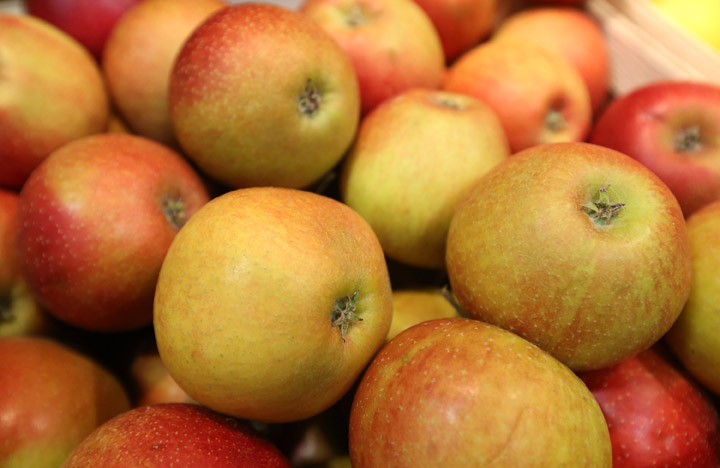Editor’s note: This story has been updated with additional information

TORONTO – Meet the new dirty dozen.
The Environmental Working Group, a U.S.-based environment and health research and advocacy organization, has updated its annual list of the best and worst foods in the produce section of your grocery store.
Fruits and vegetables are ranked according to the amount of pesticide residues they contain.
EWG compiled the list by analyzing data from the U.S. Department of Agriculture and the FDA on 48 popular fruits and vegetables.
USDA personnel washed or peeled more than 28,000 samples before testing the items in order to mimic consumer behaviour (although many consumers eat fruit and veggies without washing them beforehand).
The fruits and vegetables that contain the highest levels of pesticides are relegated to the “Dirty Dozen” list, and those produce items that are considered the least likely to contain pesticides make up the “Clean Fifteen” list.
New additions to the Dirty Dozen this year include cherry tomatoes and hot peppers. The 2013 EWG’s shoppers guide also highlighted two crops – summer squash and leafy greens, specifically kale and collard greens – saying that although they don’t meet the traditional criteria for the list, are often contaminated with pesticides “exceptionally toxic to the nervous system.”
The 2013 Dirty Dozen
- Apples
- Celery
- Cherry tomatoes
- Cucumbers
- Grapes
- Hot peppers
- Nectarines – imported
- Peaches
- Potatoes
- Spinach
- Strawberries
- Sweet bell peppers
- Kale/collard greens+
- Summer squash+
The 2013 Clean Fifteen
- Asparagus
- Avocados
- Cabbage
- Cantaloupe
- Sweet corn
- Eggplant
- Grapefruit
- Kiwi
- Mangoes
- Mushrooms
- Onions
- Papayas
- Pineapples
- Sweet peas – frozen
- Sweet potatoes
The EWG said unwashed produce is more likely to contain higher concentrations of pesticide residues, but washing produce isn’t enough to remove pesticides. Even after a power-washing treatment just a single grape tested positive for 15 different pesticides.
“The pesticide gets right into the flesh, it doesn’t just sit on the surface of the skin,” said holistic nutritionist Joy McCarthy on Global News’s The Morning Show Tuesday.
Recommendations for consumers looking to reduce their exposure to pesticides include buying organic produce, looking for items with thick peels such as pineapples and cantaloupe, and buying locally-grown food.
Experts believe this advice is particularly important for people with young children.
“We believe the most vulnerable population would be infant and children, in part because of their small body weight,” said Dr. Chensheng Lu, associate professor of environmental exposure biology at the Harvard School of Public Health.
“Also they’re still growing, so there’s a lot of detoxifying mechanisms that we have as adults that they don’t have yet,” said Lu.
- B.C. to ban drug use in all public places in major overhaul of decriminalization
- Posters promoting ‘Steal From Loblaws Day’ are circulating. How did we get here?
- Canadian food banks are on the brink: ‘This is not a sustainable situation’
- 3 women diagnosed with HIV after ‘vampire facials’ at unlicensed U.S. spa
Despite recommendations from various experts to reduce consumption of pesticide residues, the USDA and the EPA report that the foods they have tested for pesticides do not pose a safety concern to consumers.
“Consistent with guidance from health and nutrition experts – and as affirmed federal nutrition guidance that urges people to make half their plate fruits and vegetables – we encourage everyone to continue to eat more fruits and vegetables in every meal and wash them before you do so,” read a statement from the USDA.
Both the EWG and McCarthy also urge consumers not to skip fruits and vegetables, saying that the benefits of eating a diet rich in produce is still better than the potential risks of pesticide exposure.
In February 2013, the USDA released data from the 2011 Pesticide Data Program (PDP) Annual Summary. The reported stated that overall pesticide levels tested below the limits established by the EPA.
Every year the USDA and EPA determine what foods will be tested on a rotating basis, focusing particularly on foods likely to be consumed by children and infants.
Since its inception in 1991, the annual PDP report has tested 109 items for pesticide levels, including produce, grains, meat and poultry products. The latest report expanded to include samples of papayas, snap peas and tangerines.
The full report can be downloaded here.


Comments